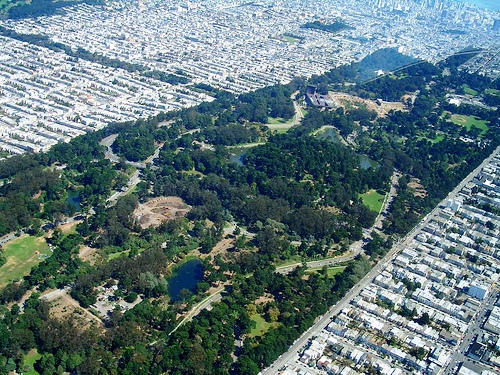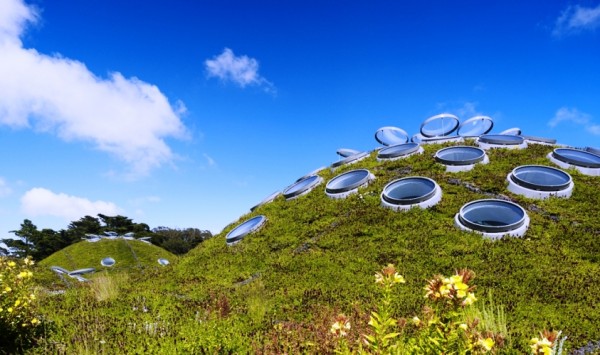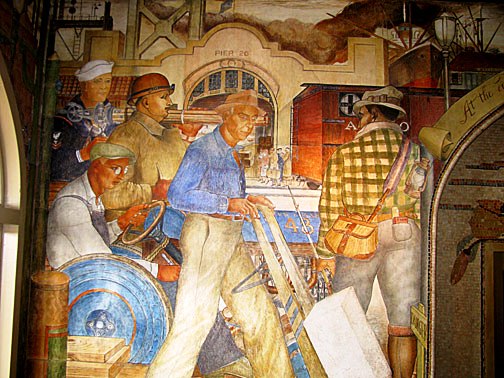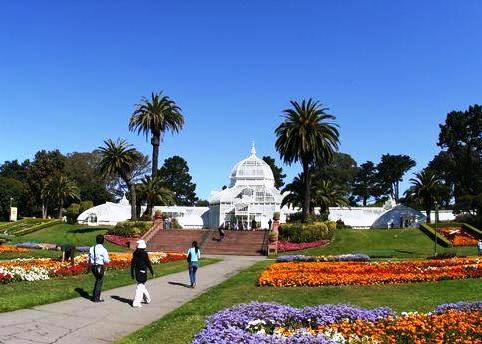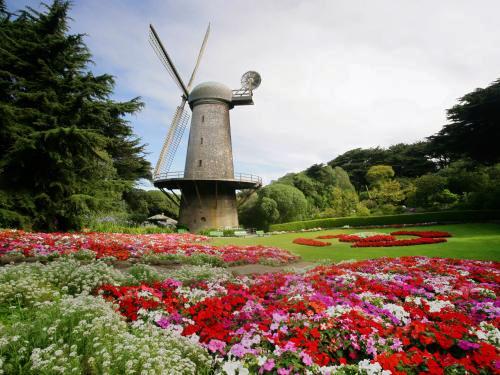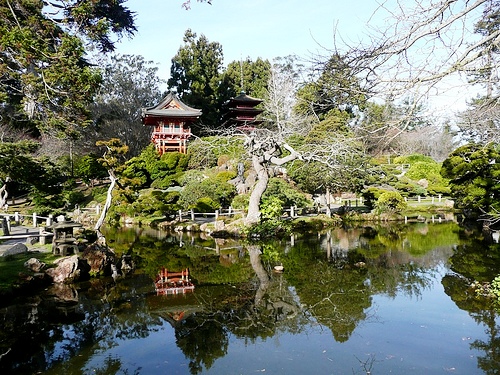When traveling to San Francisco, most people limit their touring of The City (this is how San Franciscans refer to their home) to the iconic, “San Franciscoey” places: Fisherman’s Wharf, the Cable Cars, Alcatraz, Telegraph Hill and Coit Tower and Lombard “the Crookedest street in the world” Street. Others will head to its famous neighborhoods, such as the Haight-Ashbury District, Chinatown and North Beach. But if you have an extra day or two, and if you are blessed with good weather, you need to spend a day in and around Golden Gate Park.
The Park, an east-west rectangle of 1,017 acres of public grounds, splits the western half of the city and stretches to the Pacific Ocean. While its shape is roughly similar in shape to New York City’s Central Park, Golden Gate Park is about but 20-percent larger. It is more than three miles (5 km) long and about half a mile wide. If you make the trip to the park, you’ll be one of 13 million people who visit the park every year—making it third-most visited city park in the U.S. (Central Park in New York City and Lincoln Park in Chicago are first and second)—although they are not all tourists, as city residents put the park to use all year round.
Many people get surprised by the summer weather in San Francisco, and while quoted ad nauseum, Mark Twain was right about it being downright cold during June, July and August. The best time to visit Golden Gate Park, in this former resident’s view (I lived in San Francisco from 1988 to 2003), is in May, September and October. The weather is gorgeous, the large expanses of lawns in the park are usually dry, and the people-watching is world-class.
If you decide to go to Golden Gate Park, these are just some of the highlights:
Academy of Sciences
55 Music Concourse Dr.
415.379.8000
One of the largest natural history museums in the world, the California Academy of Sciences is enjoying its second life. Damaged during the 1989 Loma Prieta earthquake, the museum reopened in 2008 in a breathtaking new building, designed by Renzo Piano. The complex is home to the Steinhart Aquarium and the Morrison Planetarium and features exhibits of reptiles and amphibians, astronomy, prehistoric life, various gems and minerals, earthquakes and aquatic life. If anything, stop by to see the building’s roof, which looks like rolling hills from some fantasy movie.
AIDS Memorial Grove
Bowling Green Drive and Middle Drive East
415.750.8340
The only national AIDS memorial in the United States; offers numerous trees, waters, meadows, and tributes. The idea for the National AIDS Memorial Grove (NAMG) was conceived in 1988 by a small group of San Francisco residents representing a community devastated by the AIDS epidemic, but with no positive way to express their collective grief. They envisioned a serene place where people would come alone or in groups to hold memorial services and to remember loved ones lost to the disease. The Grove is an award-winning example of civic beautification, combining both public and private sectors in urban-park restoration and promoting AIDS awareness. The Grove has become a model project for like-minded groups throughout the world.
The Beach Chalet
1000 Great Highway (at Fulton)
415.386.8439
The two-story Beach Chalet, which faces the Great Highway and Ocean Beach at the far western end of the park, is another Golden Gate Park venue enjoying a new lease on life. Originally opened in 1925 as a city-run restaurant, it sat shuttered for several years before a renovation in 1996 that led to the building housing the Beach Chalet Brewery and Restaurant on the second floor. A second restaurant, the Park Chalet, is in the rear of the Beach Chalet facing the park and features outdoor dining. Something to note while waiting for a table is the intricate Works Progress Administration murals painted on first-floor walls in 1936 depicting the people of San Francisco. The San Francisco Visitor’s Center (415.751.2766) is also located on the first floor.
Bison Paddock
John F. Kennedy Drive between Chain of Lakes Drive and Spreckels Lake
In the late 1800s, when the population of the North America bison had dwindled to an all-time low, San Franciscans endeavored to breed them in captivity to help stem the species’ decline. Because of that effort, bison have lived continuously in Golden Gate Park since 1899, when the paddock in the park’s western section of the park was created. The animals today are cared for by staff from the San Francisco Zoo.
Botanical Garden at Strybing Arboretum
1199 Ninth Avenue at Lincoln Way
415.661.1316 ext. 312 (Tours)
http://www.sfbotanicalgarden.org/
The San Francisco Botanical Garden was laid out in the 1890s, but was unable to find funding until Helene Strybing willed funds in 1926. Planting began in 1937 with WPA funds supplemented by local donations and today the arboretum covers some 55 acres and features more than 7,500 plants. The arboretum also houses the Helen Crocker Russell Horticultural Library.
Conservatory of Flowers
JFK Drive
415.666.7001 (Information)
http://www.conservatoryofflowers.org
The Conservatory of Flowers is one of the largest conservatories of its kind in the world. Built of wood and glass panes, the prefabricated conservatory was originally intended to be built at the Santa Rose estate of a local entrepreneur, but the man died in 1867 before beginning the project so the building sat, unassembled and sitting on pallets, when a group of San Franciscans bought it and offered it to the city. The conservatory’s grand opening was held in 1879, but seems to have had a cursed existence, catching fire after a boiler explosion in 1883, surviving the 1906 earthquake only to catch fire again in 1918. It was closed between 1933 and 1946 because the construction was deemed to be unsound, and after repairs, 100 mph winds blew out 40 percent of the windows and damaged the structure again. After painstaking remodeling and repairs, it reopened in September 2003. All the work has been worth it as the building is beautiful and the greenery inside offers an amazing variety, including a really cool carnivorous plants display.
de Young Museum
50 Hagiwara Tea Garden Drive
415.863.3330
http://www.thinker.org/deyoung
Another of the facilities in Golden Gate Park that needed retrofitting after the 1989 quake, the de Young was rebuilt from the ground up. Named for M. H. de Young, the San Francisco newspaper magnate, the De Young Museum is filled with international displays of fine art and creativity. The museum houses collections of American art from the 17th through the 20th centuries, and art of the native Americas, Africa and the Pacific. Along with the Academy of Sciences and the Japanese Tea Gardens, the de Young is a near-standard field trip stop for elementary school children from around the Bay Area.
Dutch Windmills and Queen Wilhelmina Tulip Garden
West end of Golden Gate Park
Campaign to Save the Golden Gate Park Windmills
415.668.0763
In 1902, the parks commission authorized construction of two windmills to pump subterranean water to supply the park. The first one, on the north side of the park facing the Pacific Ocean, was completed in 1903 and became known first as the North Windmill and later as the Dutch Windmill; it is now paired with the Queen Wilhelmina Tulip Garden, a gift from the Dutch monarch. The gardens are planted with tulip bulbs for winter display and other flowers throughout the seasons. The second, Murphy’s Windmill, on the south side of the park, began operation in 1908. The pair operated for several decades, but fell into disrepair after the park switched to electric water pumps. The Dutch Windmill was restored in 1981, but, as of 2009, Murphy’s Windmill’s restoration is still in progress
Golden Gate Park Golf Course
47th Avenue between JFK Drive and Fulton Street
415.751.8987
http://goldengateparkgolf.com/
A nice little pocket gold course, the GGPGF offers a nine-hole pitch-and-putt course. It is advertised as “the place San Franciscans learn to golf,” an in my case, I can say this is true. The par-3 course is ideal for beginners but challenging enough for those who know their way around the links. The course features a practice range, tournaments, special events, golf lessons and the Ironwood BBQ restaurant
Japanese Tea Garden
Tea Garden Drive and Martin Luther King Jr. Drive
415.752.4227
If you are looking for a place to take a little time off or for a little Zen, these five acres of calming surroundings, relaxing natural scenery and teahouse is the place to do it. The Japanese Tea Garden is the oldest public Japanese garden in the United States, designed by Makoto Hagiwara for the California Midwinter International Exposition of 1894. Of all the original structures built in the park, the Tea Garden’s Drum Bridge and the tea house have stood solid through the two major earthquakes and more than a century of harsh weather.
Picnic Table Reservations
415.831-5500
While you can park just about anywhere along the many roads snaking through out the park, throw down a blanket and have a picnic, actual picnic tables are sometimes scarce and usually reserved in advance. If you’re going to want a table, call ahead and try to grab one, especially on a good-weather weekend day.
Post and photos (unless otherwise noted) by Gregory Watkins.
